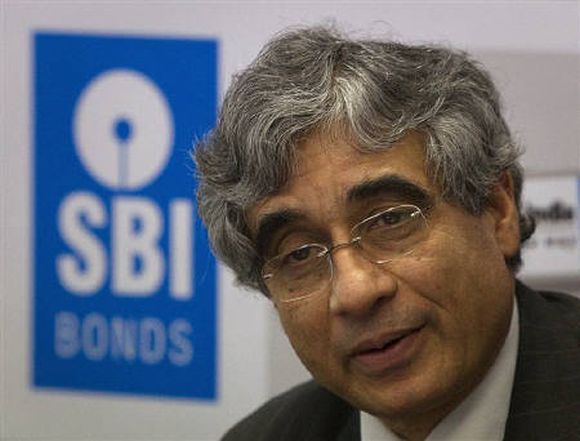Photographs: Reuters Somasroy Chakraborty in Kolkata
The disturbing trend in the country's largest bank continues: as soon as State Bank of India (SBI) has a new chief, its profit plummets and bad loans mount.
The bank's new chairperson, Arundhati Bhattacharya, became the latest victim of this disconcerting phenomenon when she announced the state-run lender's second-quarter earnings last week.
SBI's profit after tax during the September-ended quarter fell 35 per cent from a year earlier as the bank had to make more provisions for the deterioration in its credit quality. It was the sharpest year-on-year decline in the lender's quarterly net profit in two years.
But Bhattacharya will probably find solace in the fact that her predecessor, Pratip Chaudhuri, had a more harrowing experience when he took charge in April 2011.
In his first quarter as SBI chairman, Chaudhuri saw the bank reporting its lowest quarterly profit in over a decade. The net profit had plunged 99 per cent on an year-on-year basis.
…
Why SBI's profit dips when a new CEO is appointed
Image: Former SBI Chief OP Bhatt.Photographs: Reuters
OP Bhatt, who was the chairman of SBI immediately before Chaudhuri, had a similar experience. The bank's profit had declined 35 per cent from a year earlier in Bhatt's first quarter as its chief.
"The chairman normally decides the way accounts are prepared. When a chairman retires, he often leaves the task of cleaning the books to his successor. Everyone wants to leave on a high note and tries to show higher profitability in the last few quarters of one's term. This trend is visible in most government banks," says a former executive of a Mumbai-based public sector bank.
While the drop in profitability may vary, the reason behind the fall remains more or less the same: higher provisions on account of non-performing assets.
In last week's earnings announcement, Bhattacharya said the bank's loan loss provisions increased 44 per cent from a year ago to Rs 2,645 crore (Rs 26.45 billion) for the quarter ended September 30, 2013.
Gross non-performing assets increased to Rs 64,206 crore (Rs 26.45 billion) at the end of the three-month period from Rs 49,202 crore (Rs 492.02 billion) a year earlier.
Gross and net bad-loan ratios deteriorated by 49 and 47 basis points, respectively, on a year-on-year basis.
The financial results reminded of SBI's earnings performance in Chaudhuri's first quarter as bank's chairman. Back then, the lender's bad loan provisions had increased 49 per cent on an year-on-year basis to Rs 3,264 crore (Rs 32.64 billion).
…
Why SBI's profit dips when a new CEO is appointed
Photographs: Reuters
Gross bad loans had increased to Rs 25,326 crore (Rs 253.26 billion) during that quarter from Rs 19,535 crore (Rs 195.35 billion) an year earlier. Gross non-performing asset ratios over total had deteriorated 23 basis points from a year ago.
Familiar trend
The investor community, it seems, has now got accustomed to a sharp dip in profit whenever there is a change in the bank's top management.
SBI's shares gained over 2 per cent on the day Bhattacharya announced the second-quarter earnings.
In contrast, the shares had fallen almost eight per cent when Chaudhuri had declared the results for the first time as SBI chairman.
Analysts believe that despite higher credit-quality stress, SBI's performance was broadly in line with their expectations.
Also, the sequential improvement in the bank's asset quality helped improve investors' confidence in the stock. SBI made cash recovery of Rs 1,414 crore (Rs 14.14 billion) and upgraded loans worth Rs 2,383 crore (Rs 23.83 billion) during the quarter.
…
Why SBI's profit dips when a new CEO is appointed
"On the asset quality front, net slippages came in at Rs 4,600 crore (Rs 46 billion), much lower than Rs 10,850 crore in the first quarter and largely in line with our expectations of Rs 5,000 crore. Given the management guidance for a restructuring pipeline of Rs 10,000 crore over the next few quarters, restructuring during the quarter at Rs 8,600 crore appeared to be a sizeable chunk of it," Vaibhav Agrawal, vice-president (research banking), Angel Broking, says.
A few analysts feel that the inexpensive valuation of SBI's shares provides investors an opportunity to make reasonable gains on investments.
The bank's shares have fallen over 30 per cent since January 10, 2013 (the day it touched its latest 52-week high).
"The strategy of the new management and the outlook would be critical on margin, asset quality and loan growth in 2013-14. All in all, it was a mixed performance and we maintain our positive stance on the bank due to reasonable valuations," Rikesh Parikh, vice-president (institution and corporate broking), Motilal Oswal Securities, says.
…
Why SBI's profit dips when a new CEO is appointed
On a sure footing
While analysts appear convinced about the bank's efforts to improve its asset quality, they caution that bad loans may mount if the lender aims to expand its business aggressively in the current uncertain macroeconomic environment.
"In our view, the most important risk is if the bank begins to compromise on its underwriting standards in its effort to grow quickly. Should that occur, we could see loan losses piling up fast. Furthermore, under the current downturn, credit quality could seriously falter, especially in a third of SBI's loans, which are to the priority sectors, and the 13 per cent that it has lent to infrastructure companies. Large loan losses on both these accounts could wipe out significant amounts of the bank's net worth," Suruchi Jain, equity research analyst at Morningstar India, said in a recent note to clients.
Bhattacharya says the bank will aim to improve its productivity, leverage technology more and use its resources efficiently to ensure that its earning capacity does not get impaired.
Bhattacharya will retire after three years and only time will tell if she will succeed in reversing the trend of lower profitability every time a new chief takes over.







article